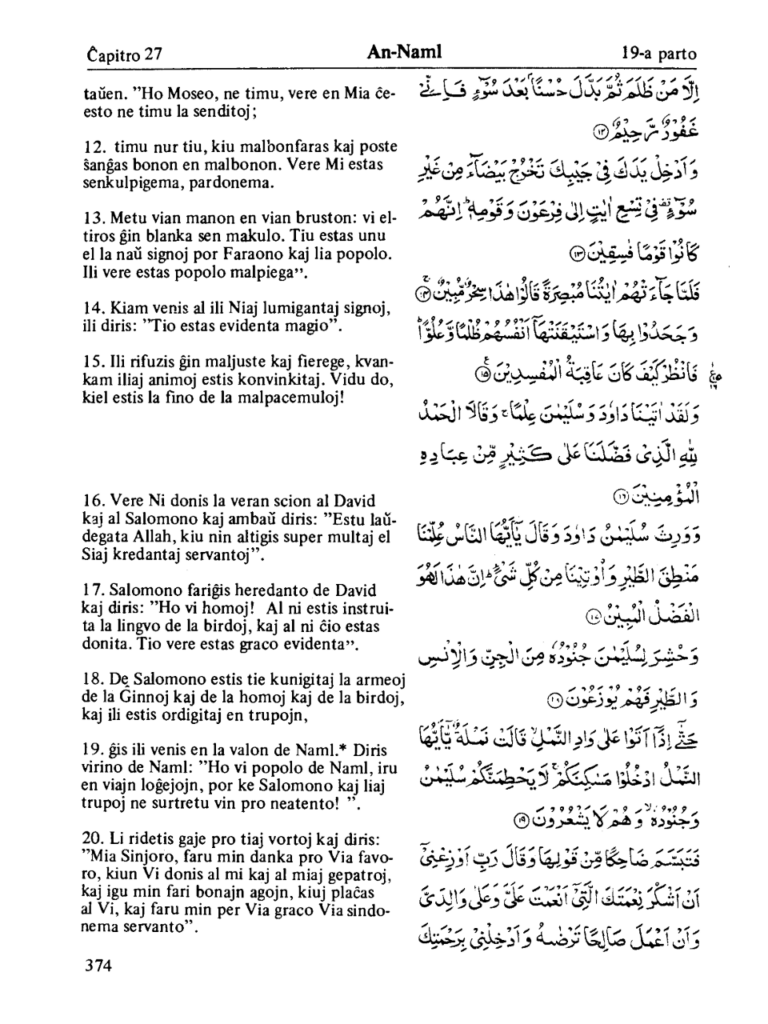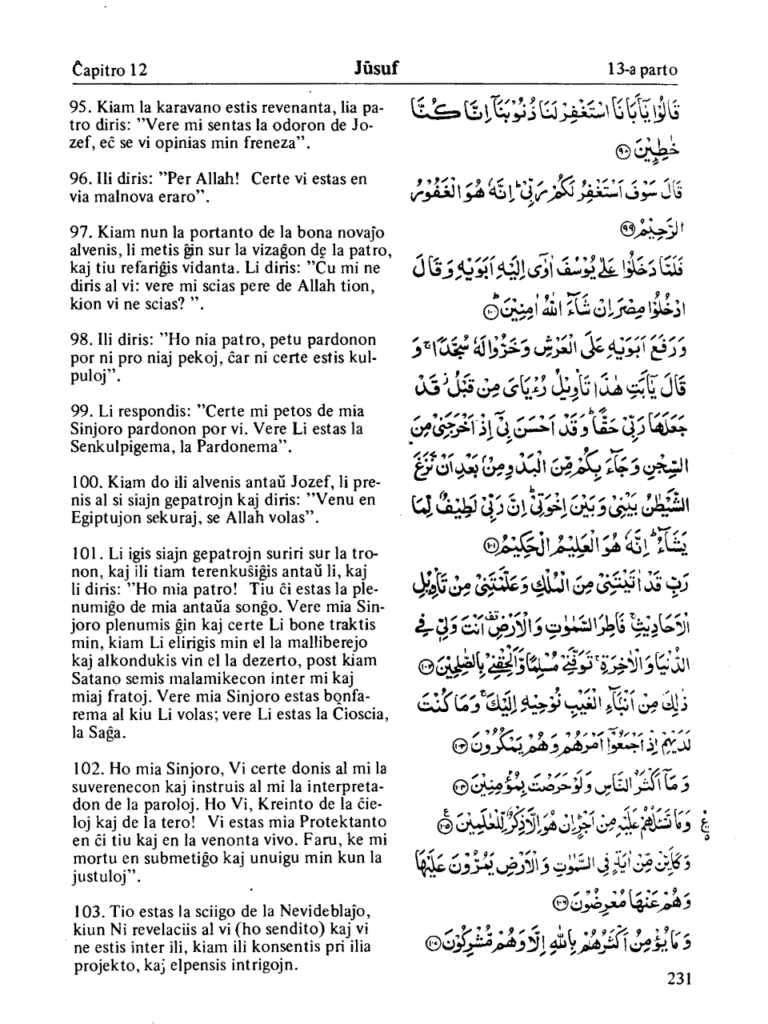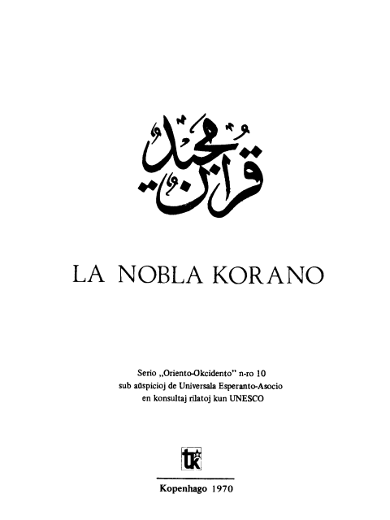How does one go about translating the Qur’an into a constructed language? This week we will be looking at Abdul Hadi Italo Chiussi’s translation of the Qur’an into Esperanto.
Esperanto ranks as the most widely spoken constructed international auxiliary language in the world. It was created by the Warsaw ophthalmologist L.L. Zamenhof in 1887 with the aim of providing an easy-to-learn language that could contribute to world peace by facilitating better international communication and improved understanding between peoples.
Interestingly, the Qur’an has been translated into Esperanto by several translators. Probably the most prominent translation is that composed by Abdul Hadi Italo Chiussi, who was from Trieste in Italy. Chiussi grew up in a devout Catholic family, and earned his doctorate in mathematics in Pisa, following which he began working in Germany as Managing Director for the Italian insurance company Generalis. While visiting the Noor Mosque in Frankfurt, Chiussi came into contact with members of the Ahmadiyya community, which had built the mosque in 1959. After his visit, Chiussi increasingly frequented the mosque and began to develop a deep interest in Islam.
In 1967, he met the third caliph of the Ahmadiyya community, Mirza Nasir Ahmad (d. 1982), and informed him during their conversation that he was translating the Qur’an into Esperanto. Two years after this meeting, Chiussi converted to Islam and became a member of the Ahmadiyya community. In the same year, 1969, Chiussi’s Esperanto translation, ‘La Nobla Korano,’ was published as the tenth volume in the series ‘Oriento-Okcidento,’ under the auspices of the Universal Esperanto Association (UEA). Prior to publication, the draft was proofread by an Egyptian Esperantist named Nasif Ishaq. According to Ahmadi sources, the translation quickly sold out, necessitating the publication of a second edition in 1970. For my analysis of the translation, I consulted this second edition.

The edition is prefaced with a note written by Ivo Lapenna, the President of the UEA, congratulating the translator on the completion of his work and setting out the two goals of the book series: firstly, the study and mutual appreciation of different cultures, and secondly, the enrichment of Esperanto literature through publication of another world-renowned work in the language. The introduction to the translation was written by Sir Zafrullah Khan (d. 1985), who at the time was a judge at the International Court in The Hague, and had previously served as Pakistan’s first foreign minister. Chiussi had good connections with Zafrullah Khan because both were members of the Ahmadiyya community. Khan mentions in the introduction that the translation might prove especially useful to those who are unable to find a translation of the Qur’an in their native language but know Esperanto. This statement underscores the Ahmadiyya’s approach of publishing translations in various languages for proselytizing purposes.
A cursory glance at the translation reveals that it follows the typical layout of Ahmadi translations: the edition is arranged in two columns, with the source text on the right and the target text on the left. Each surah is preceded by its Arabic name in transcription, followed by a literal translation in parentheses. In addition, reference is made to whether the surah was sent down in Mecca or Medina. The verse count also corresponds to the Ahmadi verse count, which is characterized by the fact that the basmalah is treated as the first verse in every surah except Sūrat al-Tawbah.
Chiussi has included footnotes in a few places to clarify the context of certain verses, or to justify his choice as a translator. This is evident, for example, in his rendition of Q 27:18, which Yusuf Ali translates as follows: ‘At length, when they came to a (lowly) valley of ants [wādi al-Naml], one of the ants [namla] said: ‘O ye ants [naml], get into your habitations, lest Solomon and his hosts crush you (under foot) without knowing.’
Chiussi makes the following choice: ‘Until they came to the valley of Naml. A woman of Naml said: ‘O you people of Naml …’
Like some Ahmadi translators before him, he points out that ‘Naml’ is not to be understood literally as referring to an ant, but rather denotes the name of a tribe that was referred to as Naml.

It stands to reason that Chiussi made use of existing Ahmadi translations when working on his own translation. However, differences also emerge, indicating that Chiussi also consulted the Arabic source text and at least a few exegetical works. For instance, Q 12:97, which talks about a man who is returning to Jacob with Joseph’s shirt, is translated by the Ahmadi scholar Sher Ali as follows: ‘And when the bearer of glad tidings came, he laid it before him and he became enlightened (irtadda baṣīran). Then he said, “Did I not say to you: I know from Allah what you know not?”’
The Ahmadi translation thus suggests that Jacob did not regain his sight by touching the shirt, but was ‘enlightened’ by seeing it that his son was still alive. In contrast, Chiussi makes the following choice: ‘When the bearer of the good news arrived he placed it on the father’s face and he regained his sight.’
It seems that Chiussi assumed that Joseph’s shirt was placed on Jacob’s face, and that this led him to actually regain his physical sight. This interpretation of the verse is supported by many classical exegetes, and supports the notion that Chiussi delved into the Arabic source text and consulted classical exegeses during the translation process. Nevertheless, for the most part, Ahmadi interpretations and ideas can be seen to be reflected in the translation. For example, Chiussi’s approach to the meaning of the ḥurūf muqaṭṭaʿāt (disjoined letters) corresponds to that found in Ahmadi interpretations of the Quran. Furthermore, since his translation is largely consistent with Ahmadi doctrinal views, this translation is promoted and used by the Ahmadiyya community for proselytizing purposes to this day.
Kamran Khan
